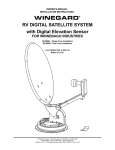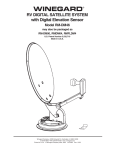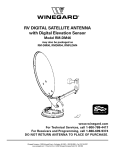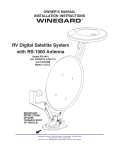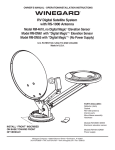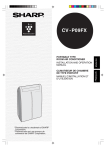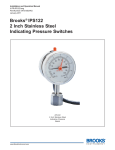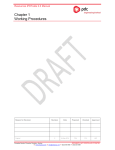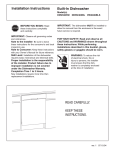Download Winegard RM-DM04 Owner`s manual
Transcript
OWNER’S MANUAL INSTALLATION INSTRUCTIONS WINEGARD ® RV DIGITAL SATELLITE SYSTEM with Digital Elevation Sensor Models RM-DM46/DM00, RM-DM04, RMFLDM4 U.S. PATENT NO. 5,532,710 Made in U.S.A. Winegard Company • 3000 Kirkwood St. • Burlington, IA 52601-2000 319/754-0600 • FAX 319/754-0787 • www.winegard.com Printed in U.S.A. © Winegard Company 2002 2451069 Rev. 8/02 1 OPERATION STEP 1. Step outside your vehicle and, using a compass, determine which direction is North. (Standing in or near vehicle can give you an incorrect reading.) The more accurately you determine North, the easier it will be to find the satellite(s). Directional Handle Elevating Crank Directional Handle Pointer FIGURE 1 Directional Dial Red Screw Rotation Clamp Step 2. Using satellite receiver, determine correct elevation for your location. See your receiver manual for details on how to obtain setup information. Step 3. Press button on Winegard Digital Display Wall plate. If antenna is in travel position the display will show LL for Low Limit; HL for High Limit, will appear when dish is in up position. Step 4. Crank elevation handle to raise antenna. Stop cranking when readout displays correct elevation for your location. Step 5. Rotate antenna VERY SLOWLY until correct satellite signal is acquired. NOTE: Rotate 3° and then stop. DO NOT rotate continuously, even if you are rotating slowly. If you notice the elevation angle has changed, it could be due to the following reasons: 1. RV is not parked level. 2. Antenna system is mounted to a slightly sloped RV roof. (This is not a problem. When you have rotated the antenna so it is facing in approximatly the right azimuth [compass direction], simply adjust to correct elevation and continue searching for signal.) Special Notes: When you have detected the satellite signal, adjust the antenna up/down and left/right for strongest signal your receiver displays. Due to variations in receivers and installation methods, you may find the elevation numbers, after peaking on the strongest signal, no longer match what the receiver recommended. This is normal. The elevation sensor should always get you close enough to pick up a signal to peak on. If display turns off while you’re searching, just push button for another minute of operation. After a little practice, most people find the signal in 30 to 50 seconds. Trouble Shooting Replacement Parts • If digital display reads EE, check wiring and connection. If these are done incorrectly, it will affect operation. • Rotate antenna VERY SLOWLY until correct satellite signal is acquired. For replacement parts, contact Winegard Company. Customer Service. Hours are 7:00 a.m. to 5:00 p.m., Monday - Thursday, and 7:00 a.m. to 4:00 p.m. Friday, Central Time. Call toll-free 1-800-288-8094. Credit card only, $5.00 minimum order. 2 TUNING ANTENNA STEP 1. Your receiver should indicate it is receiving a signal. To tune your antenna for the best signal strength, slowly move the antenna left, then right until you have found the position that gives the highest signal strength. It is important to turn the antenna slowly; since the signal is digital the receiver takes a few seconds to lock on. STEP 2. Place rotation clamp in the LOCK position. This prevents the antenna from moving and losing the signal. STEP 3. Slowly raise, then lower the antenna until you have peaked the signal. You are now ready to watch satellite TV! LOWERING ANTENNA TO TRAVEL POSITION STEP 1. Set rotation clamp to the ROTATE position. STEP 2. Rotate antenna until pointer on directional handle aligns with the red screw on the rotation clamp. STEP 3. Turn elevating crank (counter clockwise) in direction of "DOWN" arrow until resistance is met. The number of turns will vary according to the elevation angle the antenna was set to. STEP 4. Move rotation clamp to the LOCK position. Antenna is now locked in travel position. STEP 5. Snap elevation crank into place. CAUTION: NEVER LOWER ANTENNA IN ANY POSITION EXCEPT TRAVEL POSITION. DO’S 1. Do check parking location for obstructions before raising antenna. 2. Do carefully raise, lower and rotate — if difficult, check for cause. 3. Do rotate slowly when searching for the satellite(s) and check fine tuning on TV set to make sure it is properly adjusted. 4. Do lower antenna before moving vehicle. 5. Activate programming by calling programming service for your receiver. DON’T’S 1. Don't move RV/coach with the antenna in the UP position. This will VOID your warranty. This may also cause damage to your roof. 2. Don’t force elevating crank up or down. Check for cause of trouble. 3. Don’t rotate directional handle hard against stops. 4. Don’t apply paint over top of base plate or anywhere on lift. 5. Don't apply sealing compound on gear housing. 3 TROUBLE SHOOTING Antenna Reflector at 900 Sig na l fr om sa tel lite 240 look angle LNBF 1. Be sure you have a clear line of sight. The signal from the satellite(s) WILL NOT pass through trees, buildings,mountains etc. Remember the antenna has a 240 offset, this means that when the antenna is straight up and down, (900) it is looking 240 into the sky. See Figure 2. 2. Do you have the TV set tuned for the correct channel 3 or 4 (same channel as output of receiver)? 3. Have you entered the correct zip for the area you are currently in? If the zip code is wrong, the antenna will be looking in the wrong direction or at the wrong elevation for the satellite signal you want. 4. Check connections at receiver, TV, and antenna. 5. Check the TV. Does it receive pictures from off-air TV stations/VCR? 6. Retune system for best picture, using procedure on page 3. 7. Inspect antenna. Make sure that it has not been damaged. If antenna is even slightly bent, the receiver may not receive any signal. 8. Contact Dealer or Winegard Service Department. FIGURE 2 ANTENNA DOES NOT ROTATE, OR IS HARD TO ROTATE 1. Inspect antenna on roof. Make sure that mount has not been damaged. 2. Check for caulking between gear housing and baseplate. 3. Be sure cables are not binding, and that they are installed properly. 4. Contact Dealer or Winegard Service Department. ANTENNA DOES NOT RAISE, OR IS HARD TO RAISE 1. Inspect antenna on roof. Make sure that mount has not been damaged. 2. Check for caulking on elevating shaft. 4. Contact Dealer or Winegard Service Department. LCD DISPLAY CODES HL ......... High Limit LL .......... Low Limit Lo .......... Battery Low Er .......... Error – – ......... Initializing NOTE: Initialization may take up to 5 seconds. 4 THINGS YOU NEED Screwdrivers (Phillips and slot) 1-3/4" hole saw 7/16" wrench ABS glue Drill w/1/8" bit Tape measure Non-hardening sealant (Check manufacturer’s specifications for compatibility with your roof material) Winegard’s Digital Elevation Sensor has been INSTALLED and CALIBRATED at the factory. INSTALLATION & ASSEMBLY STEP 1. Choose a location on the roof for dish that will allow dish to raise and rotate without interfering with other roof-mounted equipment. Make sure inside ceiling plate is easily accessible, and with no obstructions that would interfere with operation. Figure 3 shows minimum distance (10") antenna should be located from edge of vehicle roof. It is recommended that you check with your dealer or manufacturer for provisions that may have been made in the roof for antenna mounting; a reinforced roof area, or pre-wire installation from the factory. FIGURE 3 The system must be level for proper operation. Winegard Model NOTE: RW-5000 roof wedge with gasket is available. If inside roof wedge is needed, Winegard’s RW-1000 can be trimmed to fit ceiling plate. Center Roof Line STEP 2. Position template on roof (pg. 8 this manual). CAUTION: DO NOT drill through wiring. Carefully drill a 1-3/4"hole through roof and ceiling of vehicle. Inspect hole to make sure wiring is intact. (Roof template, pgs. 8-9.) It is highly recomended that the antenna be mounted on roof center line. Do not mount antenna closer than 10" from edge of roof. 19.50" 34" DIA. OPERATING AREA 26" RW-5000 Roof Wedge w/gasket 17" RADIUS Minimum 10" Front of the RV Vehicle Roof Antenna Controls NOT TO SCALE Interior Roof Wedge (optional) 5 (4) Antenna Mounting Bolts STEP 3. Assemble dish to backup using bolts and nuts provided, Figure 4. STEP 4. Mount dish on roof in upright position. Rotate clockwise to stop, Figure 5. Dish will be toward back of vehicle when in stowed or travel position. The word FRONT is embossed on the base. This should face front of vehicle. Secure to roof using screws (provided). The travel bracket should be mounted to roof 6-1/8" from base of dish, toward back of vehicle. See Figure 6. FIGURE 4 (4) 1/4 - 20 Hex Nut NOTE: Apply non-hardening sealing compound to screw heads, coax access hole and edge of gasket under mount base. Install the vent tube on the back of the mount base (This is the side opposite the word FRONT). The hole for the vent tube is shown in Figure 6A. CAUTION: DO NOT seal hole in vent tube. Put sealant around the outside of the vent tube, approximately 1/2" from end. Push the vent tube into the hole. The sealant will seal the hole as you push in. Leave approximately 2 to 2-1/2" of the vent tube extending from the hole. Put a small amount of sealant on the roof under the vent tube end to hold in place. FIGURE 5 Measure coax 24" at plastic fastener on left side of feed arm. (See Step 5.) Rotate clockwise to stop Cable entry plate placement is 3" minimum from mount base. FIGURE 6A Sealant Vent tube 1/2" CAUTION: DO NOT GET sealing compound between Base Plate and Rotating Gear Housing. DO NOT PAINT top of Base Plate or around Rotating Gear Housing. FIGURE 6 Base plate STEP 5. Facing the front of the dish, note the coax attached to side of the feed arm. Measure 24" of coax from this point. Do not cut. Put coax around mount base, Figure 5. Fasten cable clamp in hole in mount base (check roof template in this manual for correct location) at the end of the coax cable measure, Figure 5. STEP 6. Apply approved sealing compound over mounting screw heads. STEP 7. Feed coax through the roof using cover plate (included with hardware), Figure 7. Weatherproof cable entry by applying sealant under lip of roof-thru plate and where cable enters roof. Attach plate to roof with screws provided. Apply sealant over screws and around edge of roof-thru plate, making sure cable entry is sealed. Secure cables as necessary to prevent whipping. If downlead connection must be made on top of roof, make sure to weatherproof connection! 6 Rev. 2/08/01 6-1/8" Travel bracket CE-2000 FIGURE 7 Downlead #10 x 1" Screws FS-8100 male-to-male F-connector Downlead connects to satellite rcvr. DIGITAL ELEVATION SENSOR ROOF CONNECTIONS The illustrations below show the different methods of connecting wires at roof level. Method will depend on model. Wire colors MUST MATCH, ie. red to red, green to green, black to black This wire harness connects to the digital elevation sensor on the antenna. Squeeze pliers until red plunger is flush with rest of terminal. 3M UR Terminal Slide wires all the way in. DO NOT strip wires, terminal is self stripping. NOTE: This terminal is NOT weatherproof and CANNOT be left outside on the roof. INSIDE RV STEP 8. Place the nut on the threaded rod. STEP 9. Measure and cut the threaded rod with a hacksaw. Use the chart, Figure 8, to determine the length. STEP 10. Remove the nut over the cut end of the threaded rod. This cleans the threads after cutting. STEP 11. Thread the cut end of the rod into the hub, STEP 12. Install the ceiling plate. The rotate/lock lever must point toward the rear of the vehicle. Be sure rotate/lock lever is pointing toward back of vehicle and hole in ceiling aligns with hole in the ceiling plate. NOTE: Make sure large and small keyways line up in the hub and directional handle! STEP 13. Measure and cut the directional handle; see Figure 9 and chart, Figure 8. NOTE: A tube cutter is recommended for cutting the directional handle. This gives a square cut; a hacksaw does not. If using an extension, see Step 17. Pliers not supplied NOTE: This terminal is weatherproof and can be left outside on the roof as LONG AS IT IS SECURED PROPERLY to prevent whipping in the wind. FIGURE 8 Roof Thickness Directional Handle Length (Figure 3E) Threaded Rod Length Worm Gear Shaft Length (Figure 3G) 1-1/2” .............. 2-7/8” ................. 2-3/4” ............... 2-7/8” 1-3/4” .............. 3-1/4” ................. 3” ...................... 3-1/8” 2” ..................... 3-1/2” ................. 3-1/4” ............... 3-1/2” 2-1/4” .............. 3-7/8 ................... 3-1/2” ............... 3-7/8” 2-1/2” .............. 4-1/8” ................. 3-3/4” ............... 4-1/8” 2-3/4” .............. 4-1/2” ................. 4” ...................... 4-1/2” 3” ..................... 4-3/4” ................. 4-1/4” ............... 4-3/4” 3-1/4” .............. 5” ........................ 4-5/8” ............... 4-7/8” 3-1/2” .............. 5-1/4” ................. 4-7/8” ............... 5-1/8” 3-3/4” .............. 5-5/8” ................. 5-1/4” ............... 5-1/2” 4” ..................... 5-3/4” ................. 5-1/2” ............... 5-3/4” 4-1/4” .............. 6-1/8” ................. 6” ...................... 6-1/8” 4-3/4” .............. 6-5/8” ................. 6-1/8” ............... 6-3/8” 5” ..................... 6-7/8” ................. 6-3/8” ............... 6-5/8” 5-1/4” .............. 7-1/8” ................. 6-5/8” ............... 7” 5-1/2” .............. 7-3/8” ................. 6-7/8” ............... 7-1/4” FIGURE 9 ³ Snap connectors together Supplied with the DM-2000 only. HANDLE LENGTH Figure 10, page 8, shows what points to measure between, with and without a roof wedge. ³ DIRECTIONAL HANDLE 7 WITH ROOF WEDGE WITHOUT ROOF WEDGE Measure from top of roof wedge to ceiling. Measure from top of roof to ceiling. TOP OF ROOF ³ TOP OF ROOF WEDGE ³ STEP 14. The directional handle and threaded rod will fit roofs up to 5-1/4" thick. If you are using wedges to compensate for roof/ ceiling slope, be sure to allow for this extra thickness. You may add an extension to the directional handle for thicker roofs. Each extension will increase the length of the directional handle by 2-1/4". FIGURE 10 CEILING ³ ³ CEILING FIGURE 11 STEP 15. Press the directional handle onto the hub. Point the arrow on the directional handle towards the rotate/lock lever to orient to the splines. Plastic Plug STEP 16. Install the washer and nut on the threaded rod. Tighten the nut enough to snug the directional handle to the hub. Spacer Spring Hub Worm Gear Threaded Rod Ceiling Plate Directional Handle STEP 17. IF YOU ARE USING AN EXTENSION, adjust the total length of the directional handle and extension by cutting the directional handle. After adjusting parts for proper roof thickness, glue the extension to the directional handle. Use ABS (plastic pipe) glue. NOTE: For roofs thicker that 5-1/4", a longer aluminum hex shaft will be needed. Contact Winegard Company for this part. CUTTING SHAFT LENGTH, Figure 3F: Flip down handle on the elevating crank handle. Slide elevating FIGURE 12 crank handle up shaft until snug against Elevating shaft directional handle. Cut elevating Mark the elevating shaft at inside shaft at inside bottom surface of surface of crank crank handle handle housing, Figure housing; shaft goes through 12. Cut shaft at mark, hex-shaped after removing crank opening by handle. Reinstall screw. crank. Crank Handle STEP 18. Check system for proper operation. Elevate dish with crank handle. A minimum of 14 turns is needed to elevate dish. Then, move directional handle with dish elevated. Directional handle should turn freely. If possible, have someone watch to make sure coax does not bind or interfere with dish movement. 8 FIGURE 13 CAUTION: After INITIAL INSTALLATION, the antenna SHOULD ROTATE APPROXIMATELY 360°FROM TRAVEL POSITION. The pointer on the DIRECTIONAL HANDLE should point towards the RED SCREW ON THE ROTATION CLAMP when in TRAVEL POSITION. ASSEMBLED VIEW Elevating Shaft Threaded Tube Rotation Clamp Pointer must point to RED SCREW at CENTER OF ROTATION CLAMP when in travel position. Red Screw 3 Directional Handle Extension 1 Ceiling Plate 2 (4) #10 Phillips Flat Head Screws 4 Directional Handle Flat Washer ALIGN POINTER WITH ANTENNA TRAVEL POSITION POINT TO BACK OF RV Nut for threaded tube CAUTION: The antenna MUST BE IN THE TRAVEL POSITION before ALIGNING the Directional Handle and Ceiling Plate. 5 ELEVATING CRANK HANDLE (When installed, extends 2-1/4" from ceiling). Snap Handle into base when not in use. Tighten screw snugly 9 DIGITAL ELEVATION SENSOR INTERIOR WALLPLATE Figure 14 Step 12. See Figure 14. If using the SM-1000 surface mount box, feed cable through hole in box. STEP 13: Connect wires coming from sensor on roof to wall plate display in vehicle. It is important to properly connect the wires at the roof and the wall plate. (Plug will click when inserted properly.) The system is designed to use a 9 volt battery OR +12 VDC from vehicle. Do not use both! IMPROPER WIRING WILL CAUSE DAMAGE TO THE PRODUCT. Cable and plug from roof sensor unit; plugs into sensor SM-1000 Surface Mount Box Sensor to readout Readout assembly STEP 14: Pressing the button when the antenna is in a vertical position should display 24 (±1°). Display will automatically turn off after 1 minute. STEP 15: Check connectors and cable entry points. #6 Bex sure 1/2" these areas are properly sealed to prevent water damage. Phillips Screw OPERATION (Also on pages 2-3) STEP 16: Using satellite receiver, find correct elevation for your location. See the receiver manual for details of setup information. STEP 17: Press button on Winegard digital display wall plate. If antenna is in travel position, the display will show LL for Low Limit. STEP 18: Crank elevation handle to raise antenna. Stop when readout displays correct elevation for your location.(Found on receiver setup menu.) Supplied with SM-1000 STEP 19: Rotate antenna VERY SLOWLY until correct satellite signal is acquired. NOTE: Rotate 3° and stop. DO NOT rotate continuously even if your are rotating slowly. If the elevation angle has changed, it could be due to the following — • Vehicle is not parked level. • Antenna system mounted on slightly sloped roof. If this is the reason, after you have rotated the antenna to the appproximate correct compass direction, adjust to correct elevation and continue search. Special Notes: When you have found the satellite signal, adjust the antenna up/down and right/left for the strongest signal your receiver displays. Due to variation in receivers and installation methods, you may find the elevation numbers after peaking on strongest signal no longer match what the receiver display recommended. This is normal. The elevation sensor should always get you close enough to pick up a signal to peak on. If display turns off while you’re searching, just push button for another minute of operation. With a little practice, most users find the signal in 30 to 50 seconds. Figure 6 DISPLAY CODES HL ................. High Limit LL .................. Low Limit Lo .................. Battery Low Er .................. Error – – ................. Initializing NOTE: Initialization may take up to 5 seconds. 10 * CAUTION: DO NOT connect to +12 VDC if using a 9 volt battery. Snap battery in place, making sure battery terminals are firmly seated on wall kplate terminals. PARTS LIST BACK VIEW (2) 1/4-20 Hex Nut P.N. 2160228 Plastic Plug O-Ring Backup Frame P.N. 2744939 (2) E-Clip for 1/4" Pin P.N. 5160818 RP-4400 (2) 1/4 x 3.25" Pin P.N. 2160813 Worm Gear Spacer Spring Screw P.N. 2160196 Pivot Shaft Part of RP-30RM kit Seal Part of RP-30RM kit Cast Aluminum Gear Housing Turret P.N. 3100728 Pivot Bearing Part of RP-30RM kit Rotate Limit Plate P.N. 3720052 Screw P.N. 2160197 Elevating Gear Part of RP-30RM kit Outer Bearing P.N. 2590347 Cutaway view of mount/gear housing Vent Tube P.N. 2200122 Turret Base P.N. 3100730 Elevate Shaft Gear P.N. 2200465 Inner Bearing P.N. 2590348 Hub P.N. 3100736 11 PARTS LIST Location of elevation sensor on backup, installed and calibrated at the factory Mounting Screws & Nuts Sensor Case 46 cm Reflector, White Backup Frame Sensor Cable (4) Flat Head Bolts (White) P.N. 2160362 Pins and E-clips LNBF LB-1000 Carriage Bolt P.N. 2160353 (not shown) Flange Nut 1/4-20 Backup Frame P.N. 2744939 Feed Arm P.N. 2744946 Screw #10-24 x 3/4 (4) P.N. 2160196 Pivot Bracket P.N. 2744945 Pin, 1/4 x 3.25" long P.N 2160813 (Not shown: E-clip for 1/4" Pin P.N. 5160818) Nylock Nut 1/4-20 P.N. 2160220 (not shown) Travel Support P.N. 2744934 Clamp (2) P.N. 2590343 Sensor parts w/cable, installed at factory Roller P.N. 2200460 Hex Head Bolt 1/4-20 x 2.5" P.N. 2160237 Interior wallplate display and parts RM-DM46 2780090 (2) 2160183 #10-32 x 1/2" Screw 12 (2) 2160216 #10-32 Hex Nut DR-4500 Wallplate Display Unit Includes (2) 2160533 #6 x 5/8" white Phillips screws (2) 2160138 #6 x 1/2" Hex Head Slotted Screw SM-1000 RM-46DE, Surface RM-FL4D, Mount Box EM-00DE PARTS LIST INTERIOR HARDWARE KIT RK-CEIL Ceiling Base Directional Dial (4) #10 Phillip Flat Head Screws Azimuth Lock Azimuth Lock Knob Directional Handle Extension Washer #10 x 3/8" Red Phillips Screw Directional Handle CRANK HANDLE KIT RK-HAND #8-32 x 3/8" Phillips Screw Crank Handle Base #8-32 Square Nut Crank Handle Knob #10 x 3/8" Phillips Screw Washer NOT TO SCALE Rev 6/11/01 13 NOTES 14 NOTES 15 SPECIFICATIONS ANTENNA & MOUNT Height when raised Height in the travel position Operating radius Roof space required LNB Weight Color Antenna height Antenna width F/D Offset angle Frequency range Gain: 11.2 GHz 12.1 GHz 12.6 GHz Aperture efficiency Cross polarization (on axis) *Beamwidth at -3 dB *Beamwidth at -10 dB Wind loading Ship weight: 30" verticle max. 8" max. 17" (34" diameter circle) 26" Compatible with DIRECTV®, DISH NetworkTM , and ExpressVu (northern U.S. and Canada) 12 lbs. Cool gray 20.9" 19.2" 0.59 24o 10.95 - 12.75 GHz 33.22 dBi 33.89 dBi 34.23 dBi 73% -21 dB 3.5o 7.0o Up to hurricane force 20.6 lbs. DIRECTV® is a registered trademark of DIRECTV, Inc., a unit of Hughes Electronics Corporation. DISH NetworkTM is a trademark of EchoStar Communications Corporation. ANTENNA/LIFT/LNBF TWO YEAR LIMITED WARRANTY Winegard Company warrants this Winegard product (excluding receiver) against any defects in materials or workmanship within two (2) yeares from date of purchase. No warranty claim will be honored unless at the time the claim is made, you present proof of purchase to an authorized Winegard dealer (if unknown, please contact Winegard Company, 3000 Kirkwood Street, Burlington, Iowa 52601-2000, telephone 319-754-0600). Winegard Company (at its option) will either repair or replace the defective product at no charge to you. This warranty covers parts, but does not cover any costs incurred in removal, shipping or reinstallation of the product. This limited warranty does not apply if the product is damaged, deteriorates, malfunctions or fails from: misuse, improper installation, abuse, neglect, accident, tampering, modification of the product as originally manufactured by Winegard, usage not in accordance with product instructions or acts of nature such as damage caused by wind, lightning, ice or corrosive environments such as salt spray and acid rain. The Two Year Warranty is provided on the condition that the equipment is properly delivered with all handling and freight charges prepaid to your Winegard dealer for repair or return to our factory at the above address. Winegard dealers will arrange for the replacement or repair and return to you, without charge, the product which failed due to defective material or workmanship. WINEGARD COMPANY WILL NOT ASSUME ANY LIABILITIES FOR ANY OTHER WARRANTIES, EXPRESS OR IMPLIED, MADE BY ANY OTHER PERSON. ALL OTHER WARRANTIES WHETHER EXPRESS, IMPLIED OR STATUTORY INCLUDING WARRANTIES OF FITNESS FOR A PARTICULAR PURPOSE AND MERCHANTABILITY ARE LIMITED TO THE TWO YEAR PERIOD OF THIS WRITTEN WARRANTY. The foregoing shall be the sole and exclusive remedy of any person whether in contract, tort or otherwise, and Winegard shall not be liable for incidental or consequential damage or commercial loss, or from any other loss or damage except as set forth above. Some states do not allow limitations on how long an implied warranty lasts, or the exclusion of limitation of incidental or consequential damages, so the above limitations or exclusions may not apply to you. This warranty gives you specific legal rights and you may also have other rights which vary from state to state. Printed in U.S.A. Winegard Company • 3000 Kirkwood Street • Burlington, Iowa 52601-2000 © Winegard Company, 2002 2451069 Rev. 8/02 16
















